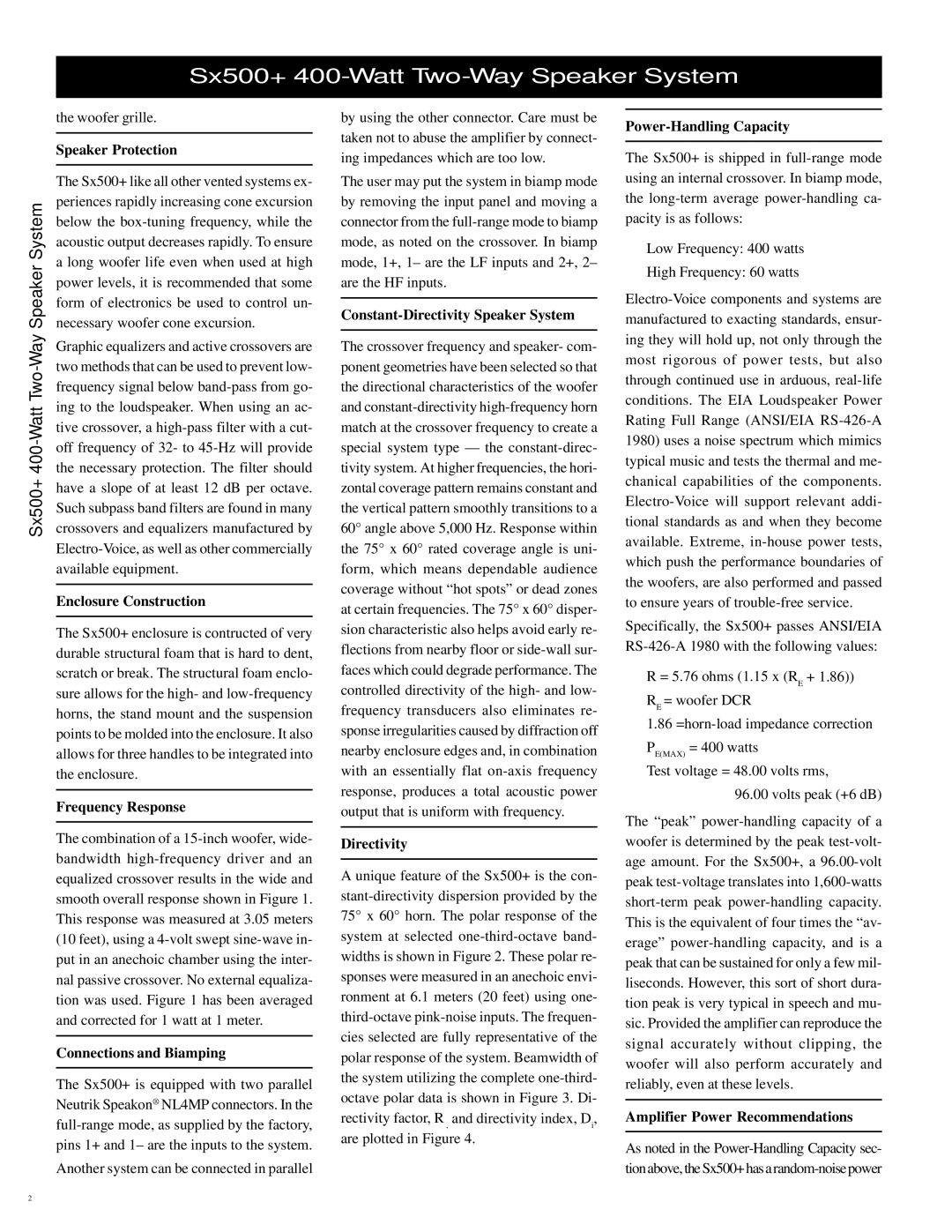Sx500+ 400-Watt Two-Way Speaker System
the woofer grille.
Speaker Protection
The Sx500+ like all other vented systems ex- periences rapidly increasing cone excursion below the box-tuning frequency, while the acoustic output decreases rapidly. To ensure a long woofer life even when used at high power levels, it is recommended that some form of electronics be used to control un- necessary woofer cone excursion.
Graphic equalizers and active crossovers are two methods that can be used to prevent low- frequency signal below band-pass from go- ing to the loudspeaker. When using an ac- tive crossover, a high-pass filter with a cut- off frequency of 32- to 45-Hz will provide the necessary protection. The filter should have a slope of at least 12 dB per octave. Such subpass band filters are found in many crossovers and equalizers manufactured by Electro-Voice, as well as other commercially available equipment.
Enclosure Construction
The Sx500+ enclosure is contructed of very durable structural foam that is hard to dent, scratch or break. The structural foam enclo- sure allows for the high- and low-frequency horns, the stand mount and the suspension points to be molded into the enclosure. It also allows for three handles to be integrated into the enclosure.
Frequency Response
The combination of a 15-inch woofer, wide- bandwidth high-frequency driver and an equalized crossover results in the wide and smooth overall response shown in Figure 1. This response was measured at 3.05 meters (10 feet), using a 4-volt swept sine-wave in- put in an anechoic chamber using the inter- nal passive crossover. No external equaliza- tion was used. Figure 1 has been averaged and corrected for 1 watt at 1 meter.
Connections and Biamping
The Sx500+ is equipped with two parallel Neutrik Speakon® NL4MP connectors. In the full-range mode, as supplied by the factory, pins 1+ and 1– are the inputs to the system.
Another system can be connected in parallel
by using the other connector. Care must be taken not to abuse the amplifier by connect- ing impedances which are too low.
The user may put the system in biamp mode by removing the input panel and moving a connector from the full-range mode to biamp mode, as noted on the crossover. In biamp mode, 1+, 1– are the LF inputs and 2+, 2– are the HF inputs.
Constant-Directivity Speaker System
The crossover frequency and speaker- com- ponent geometries have been selected so that the directional characteristics of the woofer and constant-directivity high-frequency horn match at the crossover frequency to create a special system type — the constant-direc- tivity system. At higher frequencies, the hori- zontal coverage pattern remains constant and the vertical pattern smoothly transitions to a 60° angle above 5,000 Hz. Response within the 75° x 60° rated coverage angle is uni- form, which means dependable audience coverage without “hot spots” or dead zones at certain frequencies. The 75° x 60° disper- sion characteristic also helps avoid early re- flections from nearby floor or side-wall sur- faces which could degrade performance. The controlled directivity of the high- and low- frequency transducers also eliminates re- sponse irregularities caused by diffraction off nearby enclosure edges and, in combination with an essentially flat on-axis frequency response, produces a total acoustic power output that is uniform with frequency.
Directivity
A unique feature of the Sx500+ is the con- stant-directivity dispersion provided by the 75° x 60° horn. The polar response of the system at selected one-third-octave band- widths is shown in Figure 2. These polar re- sponses were measured in an anechoic envi- ronment at 6.1 meters (20 feet) using one- third-octave pink-noise inputs. The frequen- cies selected are fully representative of the polar response of the system. Beamwidth of the system utilizing the complete one-third- octave polar data is shown in Figure 3. Di- rectivity factor, R , and directivity index, Di, are plotted in Figure 4.
Power-Handling Capacity
The Sx500+ is shipped in full-range mode using an internal crossover. In biamp mode, the long-term average power-handling ca- pacity is as follows:
Low Frequency: 400 watts
High Frequency: 60 watts
Electro-Voice components and systems are manufactured to exacting standards, ensur- ing they will hold up, not only through the most rigorous of power tests, but also through continued use in arduous, real-life conditions. The EIA Loudspeaker Power Rating Full Range (ANSI/EIA RS-426-A 1980) uses a noise spectrum which mimics typical music and tests the thermal and me- chanical capabilities of the components. Electro-Voice will support relevant addi- tional standards as and when they become available. Extreme, in-house power tests, which push the performance boundaries of the woofers, are also performed and passed to ensure years of trouble-free service.
Specifically, the Sx500+ passes ANSI/EIA RS-426-A 1980 with the following values:
R = 5.76 ohms (1.15 x (RE + 1.86)) RE = woofer DCR
1.86 =horn-load impedance correction
PE(MAX) = 400 watts
Test voltage = 48.00 volts rms,
96.00 volts peak (+6 dB)
The “peak” power-handling capacity of a woofer is determined by the peak test-volt- age amount. For the Sx500+, a 96.00-volt peak test-voltage translates into 1,600-watts short-term peak power-handling capacity. This is the equivalent of four times the “av- erage” power-handling capacity, and is a peak that can be sustained for only a few mil- liseconds. However, this sort of short dura- tion peak is very typical in speech and mu- sic. Provided the amplifier can reproduce the signal accurately without clipping, the woofer will also perform accurately and reliably, even at these levels.
Amplifier Power Recommendations
As noted in the Power-Handling Capacity sec- tion above, the Sx500+ has a random-noise power

